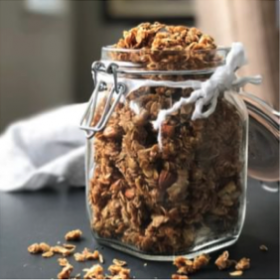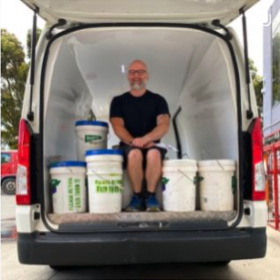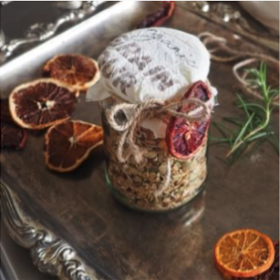By Ruth Friedlander
Along with my usual new years resolutions (exercise more, be more productive, spend more time in the garden) this year I have been prompted to add a new one to the list: stop wasting food. It comes at a time when climate change is of huge concern, crops are being damaged due to unpredictable weather, and financially things aren’t going well for millions of people around the world. It seems an apt time to assess the rate in which we consume and discard valuable produce. According to a 2009 survey conducted by the Australia Institute, a think tank based in Canberra, Australian households collectively waste more than $5 billion worth of food each year – $1.1 billion worth of fruit and vegetables alone. Aside from the obvious financial repercussions of this much food wastage, there is an environmental toll that comes with it, as the more food wasted, the more water and land needed to grow it, as well as the increased emissions due to transport and storage of the doomed produce. At the other end of the chain food stuff destined for the rubbish bin will also play its part in increasing emissions, with almost half of all municipal waste being comprised of organic material, the decomposition of which is the main source of greenhouse gas emissions from landfill. The report based on the 2009 survey, What a waste: An analysis of household expenditure on food, prepared by David Baker, Josh Fear and Richard Denniss, points out that this rotting organic waste results in a “rate of pollution that is similar to the total emissions involved in the supply of iron and steel in Australia”.
While purchasing produce from local sources is a step in the right direction, making sure that produce stays out of the rubbish bin is just as important. So with this in mind I’ve compiled a few tips and tricks below which I’ll be making the most of this year.
Make your own stock.
Do you have a few limp sticks of celery sitting in the back of the vegetable box? How about a couple of onions and carrots lying around? If so, then you have all you need to make your own vegetable stock for use in soups, stews, curries and risottos. Or try putting your food scraps to good use in a stock: save the stalks from mushrooms, the leaves and ends from celery, the ends from carrots and the stalks from parsley. You can also throw eggshells into the stock pot, which will release calcium when cooked. Check out this link if you don’t believe me. (http://www.thesweetbeet.com/vegetable-stock/)
The following vegetables, fruits and herbs are perfect for stock, simply throw them whole or roughly chopped (no need to peel anything) into a large stock pot, cover with water, add a few peppercorns and simmer for about an hour. Strain through a fine meshed sieve – lined with muslin if available – and there you have it, homemade stock ready to freeze in batches for use in a range of dishes. I tend to not salt my stock, preferring to season the final dish instead.
vegetables, herbs and fruit for the stock pot: Onions, garlic, carrots, celery, leek, potato, parsnip, zucchini, lettuce, beans, mushrooms, tomatoes, apples, rosemary, thyme, parsley, bay leaf, peppercorns.
Preserve
Preserving is a great way to use up an excess of fruit or vegetables that may have escaped the dinner plate. All you need are a few old jars, some vinegar, sugar, salt and a few different spices to get you started. From apricot chutney, to plum jam, to beetroot relish, to bread and butter cucumbers, almost anything can be preserved and turned into a delicious spread or condiment. You don’t need a massive haul of produce to do it either, it’s worth preserving just a small jar of fruit or vegetables for your own use over the following weeks.
Poach or stewed excess fruit is a great thing to keep in jars in the fridge for cereal toppings or quick crumbles, and a favorite of mine, oven dried tomatoes in olive oil, makes for a decadent snack when placed on top of toasted rye bread smeared with a soft goats cheese.
There are endless ways to preserve produce (did I forget to mention fruit infused liqueurs?!) so go ask your grandma, or google, for some tips and recipes to start you on your way.
Freeze
Some weeks there are just too many nights out, or trips away, to consume all of the vegetables in your CERES fair food box. So plan ahead and get those veggies in your freezer. Whether as they are, or cooked up into a hearty soup for easy reheating when convenience food is a must, freezing produce works beautifully as an alternative to food waste. This link has some great advice on freezing food, with instructions on page 3 for freezing fresh vegetables. (http://www.bbcgoodfood.com/content/recipes/features/freezing/1/)
Bake
Who can say no to a slice of freshly baked fruit pie, carrot cake or chocolate zucchini brownie? Well ok, maybe a few could say no to that last one, but I’m convinced it’s only because they haven’t yet discovered the joys of baking with zucchinis. Regardless, baking is the perfect way to use up vegetables like zucchini, carrot and pumpkin, and any extra fruit you may be left with. Another bonus, your friends, family and colleagues will love you for it. Win win.
Swap
So maybe you’re not a beetroot fan, or perhaps you have a residual childhood fear of broccoli or cauliflower. It doesn’t mean these poor and often misunderstood vegetables should go to waste. Instead, bring them to a friends place the next time you’re visiting. In return you may just get a great big bunch of flowers, or better yet, basil, from their backyard.
Any other tips or techniques that may help curb household food wastage? Feel free to add to the list in the comments section below.





We actually freeze the ends of carrots, bits of celery, onion etc in ziplock bag to make batches of stock, either once accumulated enough, but more often with the bones from a roast chook.
Meal planning at our place has helped ensure we incorporate all those delicious ingredients across dinners, lunches, baking and snacks. It also helps use pantry and other items from the fridge & focus any trips to the market.
And finally any “bad” bits or produce that escapes the eatability window goes to the worm farm, bokashi bin or compost heap.
Thanks for a timely reminder. Good luck with the resolutions!
Couldn’t agree more whole heartedly with the meal planning. We only buy what we need for the meals we intend on cooking and snacks for morning, afternoon tea etc. Our wastage is minimal and all scraps are sent to the compost. Our bin is one of the only ones in the street that has a closed lid on ‘bin-night’!! Go figure!
So, if you want to give them a gift that they will appreciate for years to come, a slow cooker is an awesome option.
Don’t forget Crockpot’s (slow cookers) are a great way to save money; My Crockpot (slow cooker) black beans are the
easiest to make, taste great and are super inexpensive and healthy.
cup of organic beef juice (grease-extracted), preferably left-over from cooking a roast or prime rib.